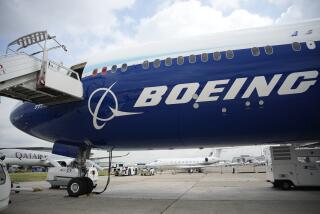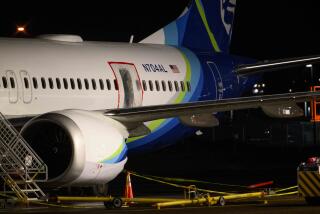Boeing Introduces New Line of 737s
- Share via
RENTON, Wash. — With thousands of employees and customers looking on, Boeing Co. on Sunday rolled out the first of its new-generation 737s, the jetliner the company hopes will become a standard in the early 21st century.
At a daylong ceremony at Boeing’s Renton facility, company executives introduced the new 737-700--the 2,843rd 737 plane to come off the production line.
Since the first 737-100 rolled out almost 30 years ago, nearly 3,600 of the twin jets have been sold, making it the best-selling jetliner ever. Of those, 501 orders are for the new version 737-600s, -700s and -800s, which Boeing says will fly faster, higher, farther, quieter and cheaper than their predecessors.
The 737 was thought to have a limited market when introduced in the late 1960s, an era when supersonic planes and big jets were expected to be the future. But the plane, with its low operating costs, became a mainstay of the short- to medium-length routes as flying became a routine part of business life and middle-class vacations.
The jet went through one reincarnation in the 1960s, when the 737-300, -400 and -500 were introduced. Those planes featured updated cockpits, new fuel-efficient engines and other improvements.
The third-generation planes, which sell for $32 million to $54 million, have received the most orders before roll-out of any commercial jet.
The 737-700 will make its first flight in February, with the first plane delivered to Southwest Airlines in October. The initial 737-800, a 162- to 189-passenger plane, will go to Hapag Lloyd in March 1998, and the 108- to 132-passenger 737-900 will be delivered to Scandinavian Airlines System in August of that year.
The new jets have a larger and more aerodynamically efficient wing than earlier 737s, which allows increased fuel capacity, longer range and higher speeds.
All three variations use the same engine, CFM International’s CFM56-7, which is more powerful but burns less fuel and is quieter than CFM’s current 737 engines.
The planes can fly up to 3,454 miles, up to 1,000 miles farther than present-day 737s, which will allow nonstop transcontinental flights in the U.S. They will cruise at 530 mph, about 30 mph faster, and fly at 41,000 feet, compared with 37,000 for the earlier planes.
More to Read
Inside the business of entertainment
The Wide Shot brings you news, analysis and insights on everything from streaming wars to production — and what it all means for the future.
You may occasionally receive promotional content from the Los Angeles Times.









